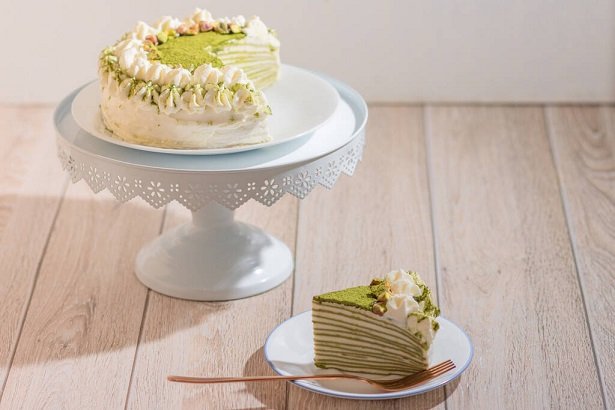Health benefits
Matcha, a finely powdered green tea originating from Japan, boasts ancient roots and numerous health benefits. Rich in antioxidants, it enhances mental clarity and metabolism while promoting relaxation through its high L-theanine content. Ideal for mindful consumption.
The Art of Creating Matcha: From Leaf to Powder
Matcha is a unique and revered form of green tea that has captivated tea enthusiasts worldwide for its vibrant colour, distinctive flavour, and cultural significance. The process of creating matcha involves meticulous steps that transform young green tea leaves into a finely ground powder cherished for its versatility and health benefits. Beyond traditional tea ceremonies, it has found its way into a diverse array of matcha dessert and culinary creations worldwide. From delicate matcha cakes ordered from Online cake shops dubai and ice creams to rich, creamy lattes, matcha desserts celebrate its unique flavour profile and vibrant colour, offering a blend of culinary innovation and cultural heritage on every plate..
Harvesting and Selection of Leaves
The journey of matcha begins with the careful selection of tea leaves, typically from Camellia sinensis plants cultivated in shaded fields. These plants are grown under shade covers for several weeks before harvest, a process that enhances chlorophyll production and gives the leaves their characteristic vibrant green colour. The shading also promotes the development of amino acids, particularly L-theanine, which contributes to matcha’s unique flavour profile and calming effects.
Steaming to Prevent Oxidation
Once the tea leaves reach optimal maturity, they are promptly harvested by hand to preserve their delicate flavour and nutrients. The freshly plucked leaves undergo a crucial step known as steaming. This process involves exposing the leaves to steam for a brief period to halt enzymatic oxidation, a natural process that can degrade the quality and flavour of the tea. Steaming preserves the vibrant green colour of the leaves and locks in their natural antioxidants and nutrients.
Drying and Preparation for Grinding
Following steaming, the tea leaves are carefully dried to remove excess moisture while maintaining their integrity and flavour. Traditionally, this drying process involves gentle heating methods such as air drying or using hot air ovens. Proper drying ensures that the leaves are crisp and ready for the next stage of production.
Grinding with Stone Mills
The hallmark of matcha production lies in its meticulous grinding process. Dried tea leaves are meticulously ground into a fine powder using traditional stone mills. These mills, made from granite or other hard stones, slowly and methodically grind the leaves to achieve an incredibly fine texture. This slow grinding process prevents overheating the tea, which can compromise its flavour and nutritional benefits. The result is a silky smooth powder with a vibrant green hue and a consistency that melts seamlessly into liquids.
Utilization in Traditional Ceremonies and Culinary Applications
The finely ground matcha powder is revered for its versatility and cultural significance. In Japanese tea ceremonies, known as “chanoyu” or “sado,” matcha is prepared and served with meticulous attention to detail, symbolizing harmony, respect, and tranquillity. The preparation involves whisking the powdered tea with hot water in a bowl until frothy, creating a ceremonial beverage known as “matcha-koicha” or “matcha-usucha,” depending on the thickness of the tea.
Beyond traditional ceremonies, matcha has gained popularity as a versatile ingredient in modern culinary applications. Its vibrant colour and earthy flavour enhance a wide range of dishes, from desserts and pastries to savoury dishes and beverages. Chefs and home cooks alike incorporate matcha into recipes for its distinctive taste and potential health benefits, including antioxidants and a gentle energy boost from its natural caffeine content.

Health Benefits and Nutritional Profile
Matcha is celebrated not only for its flavour and cultural significance but also for its potential health benefits. As a powdered form of green tea, matcha retains a higher concentration of antioxidants, vitamins, and minerals compared to steeped green tea. The presence of catechins, particularly epigallocatechin gallate (EGCG), contributes to matcha’s antioxidant properties, which may support overall health and well-being.
Furthermore, matcha contains L-theanine, an amino acid known for promoting relaxation without drowsiness, thereby enhancing focus and concentration. The combination of L-theanine with caffeine provides a balanced and sustained energy boost, making matcha a popular choice for those seeking a natural alternative to coffee or energy drinks.
matcha dessert FAQs
What does matcha taste like in desserts?
Matcha in desserts offers a unique flavour profile; it is subtly sweet with a slightly bitter, earthy undertone. Its vegetal notes complement both rich and delicate ingredients, creating balanced and intriguing treats that delight the palate.
What goes well with matcha dessert?
Matcha desserts pair beautifully with flavours like white chocolate, red bean paste, and fresh berries. Creamy textures such as mascarpone or vanilla yoghurt also complement the earthy notes of matcha, enhancing the overall taste experience.
What Japanese sweets are eaten with matcha?
Traditional Japanese sweets such as wagashi, including mochi, dorayaki, and daifuku are commonly enjoyed with matcha. These confections often feature flavours like azuki bean paste or flavoured rice cakes, complementing the bitterness of green tea.
Why is matcha used in desserts?
Matcha is commonly used in desserts due to its vibrant green colour, distinct earthy flavour, and numerous health benefits. It adds a unique taste profile while providing antioxidants, making it an appealing choice for creative culinary recipes.
